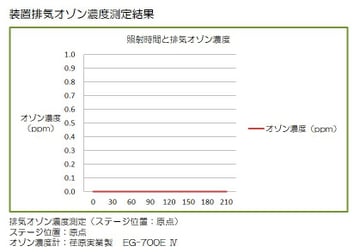Do I need to use it shaded?
For added safety, the ASM86 Excimer has a light-shielding cover over the light source and an interlock that immediately turns off the light if the entrance is opened.
Does the ASM86 Excimer require N2 (nitrogen) purging?
The ASM86 Excimer basically does not require N2 (nitrogen) purging.
Is an initial warm-up operation necessary?
Excimer lamps can be turned on instantaneously. Unlike low-pressure mercury lamps, no special warm-up operation is required.
Is there anything I should be careful about in terms of irradiation distance from the lamp?
Keep the distance between the excimer lamp light source and the object to be treated close. The recommended distance is within 5 mm. The greater the distance, the more the excimer light is absorbed by oxygen and the less effective it becomes. For this reason, the excimer lamp is suitable for treating workpieces that are not uneven, such as films and flat plates.
How much heat is generated from the excimer lamp?
The lamp surface used by the ASM86 Excimer can reach a maximum temperature of about 200°C. For heat-sensitive samples, the irradiation time should not be too long.
Is there any workpiece that should not be used?
Never add fluorocarbon resin. Fluoropolymer may decompose and adversely affect the lamp.
Is it possible to perform excimer irradiation of film-like workpieces?
Yes, it is possible. However, it is necessary to ensure that the film does not flap because of the suction used for ozone exhaust.
What is the irradiation position in the moving irradiation mode (scan mode)?
The moving irradiation mode (scan mode) is an operation mode that passes directly under the excimer lamp's issuing surface (width 86 mm, depth 40 mm).

What is the irradiation position in stop irradiation mode (stop mode)?
The stop irradiation mode (stop mode) is an operation mode in which irradiation is performed after stopping directly below the excimer lamp's emission surface (width: 86 mm, depth: 40 mm).

What is the maximum thickness of the sample workpiece?
The ASM86 Excimer can irradiate up to 40 mm thick.
How should the cleaning be evaluated?
The most common method is to measure the contact angle using a contact angle meter. For simple confirmation, a dyne pen can be used to determine the contact angle. In some cases, XPS is used to determine the contact angle at the atomic level.
How long will the treatment effect of the modification last?
Depending on the material, it will return to its pre-irradiation state over the elapsed time after treatment.
How should ozone exhaust be performed?
Can I try ASM86 Excimer?
Rental loaner equipment is available. Please feel free to contact us.
Are there any legal restrictions on the use of ASM86 Excimer?
The ASM86 Excimer is not subject to notification of the installation of radio frequency application equipment in accordance with the Radio Law.
What processes are used for excimer cleaning?
It is especially used for wet pre-cleaning of TFT LCD glass substrates and film deposition processes.
Where should I look for the distance between the excimer lamp and the workpiece?
Measure the distance in the photo below and add 0.6mm for the lamp setback.




